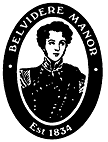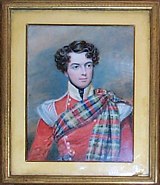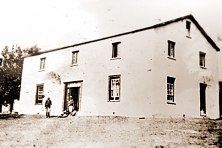- Home
- Community
- Business
-
Tourism
- Towns
- Accommodation
- Attractions
- Activities
- Gallery
- Maps
- Outings
- Pet-friendly accommodation
- S.A. Distance Chart
- Tide Chart
- Tourism Offices
- About Us
- Products
- User Menu

The Belvidere story begins long after the first settlers picked up shellfish and fished from the shores of the gentle estuary. Originally part of a huge farm named Buffelsvermaak (owned by Pieter ter Blans) which stretched from the Goukamma River to the lagoon and from the sea to the border of another spacious farm Sandkraal, later known as Westford, a portion was named Uitzigt and was granted to one Hendrik Bernard in 1818 to graze his cattle. In 1830, George Rex bought the farm from Bernard’s deceased estate and renamed the farm Belvidere. Already partly cultivated, as Bernard had been reasonably prosperous with crops, cattle and timber, Rex added this lovely property to his estate which then amounted to more than 24 000 acres.
Why Belvidere? As an Englishman its not surprising that Rex replaced the Dutch Uitzig with Belvidere, meaning “a platform, tower or raised place commanding a beautiful view”. Much has been queried about the change from e to I, but Belvedere is Italian in origin derived from bella (beautiful) and vedere (to see), whereas the British favour the Latin root videre as in videotape. Rex as a lawyer was well versed in Latin, hence that version.
 Captain Thomas Henry Duthie was an ensign in the 72nd Highlanders, and was posted to the Cape of Good Hope. Here he had the responsibility of handling a military detachment as well as convict labour constructing what is now Sir Lowry’s Pass at Houw Hoek. After the completion of the pass Duthie took two months leave to visit the eastern frontier to hunt and on the way he visited George Rex in Knysna. He was entertained on a bushbuck hunt, went shark fishing and also tried to trap a hyena. He enjoyed picnics, and was entertained with music and dancing in the evening. So it wasn’t a surprise that he should visit Knysna again on his return journey a couple of months later, and over the next couple of years Thomas conducted a leisurely courtship and in October 1832 requested George Rex for his daughter Caroline’s hand in marriage. They were married in February 1833 and departed to England where spent the next 18 months, and where their first child, named Caroline after her mother, was born in November. However, they returned to Cape Town and on 7 October 1834, Thomas Henry Duthie paid his father-in-law £750 for the farm Belvidere. By April 1835 they had built their first small house and moved in.
Captain Thomas Henry Duthie was an ensign in the 72nd Highlanders, and was posted to the Cape of Good Hope. Here he had the responsibility of handling a military detachment as well as convict labour constructing what is now Sir Lowry’s Pass at Houw Hoek. After the completion of the pass Duthie took two months leave to visit the eastern frontier to hunt and on the way he visited George Rex in Knysna. He was entertained on a bushbuck hunt, went shark fishing and also tried to trap a hyena. He enjoyed picnics, and was entertained with music and dancing in the evening. So it wasn’t a surprise that he should visit Knysna again on his return journey a couple of months later, and over the next couple of years Thomas conducted a leisurely courtship and in October 1832 requested George Rex for his daughter Caroline’s hand in marriage. They were married in February 1833 and departed to England where spent the next 18 months, and where their first child, named Caroline after her mother, was born in November. However, they returned to Cape Town and on 7 October 1834, Thomas Henry Duthie paid his father-in-law £750 for the farm Belvidere. By April 1835 they had built their first small house and moved in.
Life at Belvidere wasn’t easy in those early years – labour was precarious, there were wild animals to contend with and stock dealers were unreliable and Thomas Duthie attempted several schemes. He intended to start salting fish to send to Cape Town and to use as barter for soap, candles etc. He was going to keep angora goats at one stage and had 230 goats that did well. A further scheme with George Rex’s 4th son, Frederick, to breed and salt cattle for their meat, and start a dairy did not go well and the agreement was cancelled after 3 months. Forest work and timber however, was to be an important part of his life, and he was appointed Supervisor of Crown Forests & Lands, Western Division of the George Districts in 1836 where he sought to control the indiscriminate felling of trees. The area where Ferry House now stands was an important loading point and timber was floated down the Knysna river then loaded and shipped out. In the early 1840’s though Duthie changed from crops to cattle and soon his herd stood at 420. He bought Westford and Portland farms from Rex’s deceased estate and these lands, combined with Belvidere gave him an area of 13 700 acres.
By 1842 the Duthies had 5 children, and were entertaining visitors regularly but it was only in 1848 that building started on their new house. Foundations were laid, and the ceremonious corner stone placed on 27th October, but it was more than a year later in November 1849 that the family enjoyed their first dinner “out of New House – good!”
 Initially a single storey building with a thatched roof, the house featured a staircase of local stinkwood and yellowwood which led up to a spacious loft running the length and breadth of the house. The thatch was gathered from marshy ground near Goukamma, timber from the forests and stones for the foundations from the beach at Brenton. Only in the 1870’s under the direction of Thomas Duthie’s 2nd son Archibald Hamilton and his wife, Augusta Vera, were the walls raised to create a second storey and the thatched roof replaced with corrugated iron which also covered the new verandahs added to the north and east sides of the building.
Initially a single storey building with a thatched roof, the house featured a staircase of local stinkwood and yellowwood which led up to a spacious loft running the length and breadth of the house. The thatch was gathered from marshy ground near Goukamma, timber from the forests and stones for the foundations from the beach at Brenton. Only in the 1870’s under the direction of Thomas Duthie’s 2nd son Archibald Hamilton and his wife, Augusta Vera, were the walls raised to create a second storey and the thatched roof replaced with corrugated iron which also covered the new verandahs added to the north and east sides of the building.
Belvidere House served as a post office during several periods in the 19th and 20th century, and copies of letters and envelopes can be seen in the sitting room today with the Belvidere postmark. A letter from Thomas Duthie to the Postmaster in Cape Town sending the proceeds of postage may also be seen.
The last direct descendent of Thomas Duthie to live at Belvidere House was another Augusta Vera, who became known as Avie Duthie. Born in 1881 Avie grew up at Belvidere and was schooled by the Duthie’s governess, Annie Armstrong who came from Ireland in 1889 when Avie was 8. Annie would serve the family for over 60 years, and was Avie’s companion into her old age. When Avie was 14 she went to the Huguenot Seminary for Girls in Wellington, and graduated with a BA degree in botany in 1901. She became a lecturer at Victoria College (later to become the University of Stellenbosch) in 1902 where she remained until she retired in 1940. Avie became one of the country’s foremost botanists and there is a 2,6 hectare reserve in Stellenbosch called the Duthie Reserve.
Meanwhile her two brothers, Williams and Alfred were at Belvidere where William was running the farm and Alfred was Rector at Belvidere Holy Trinity Church. But their early deaths caused Avie to return to Belvidere in 1939, aged 58 to manage and look after the estate. This was a daunting job for a woman, along with caring for the welfare of all the Coloured families living at Belvidere and it occupied her attention for more than 25 years. Her great tower of strength over this period was Annie Armstrong, her beloved governess who returned to become her cherished friend until Annie died aged 88 in 1952.
By this time Belvidere had been reduced in size by the sale of plots for several permanent and holiday homes, and of large holdings above the railway line towards Brenton. Vegetables, milk and cattle feed were the farm’s main produce but it was hard work. However, Avie cared for it as much as she could and ensured that her staff and families were looked after.
When she died in 1963 the over-riding purpose of her will was “to preserve the tradition and atmosphere of Belvidere as laid down by the Founder” She had gone into unusual detail to ensure this as well as providing for the maintenance and good order of the Holy Trinity Church and its grounds. She wanted to prevent too great a density of population in the village (the subdivision of plots was banned) and a guarantee that no residence or dwelling of less than £1500 in value be erected. Suitable purchasers were to be approved and any proceeds of land sold were to be invested in a special Trust Fund with the income produced paid to the Diocesan Trustees in George and used for the maintenance and beautification of the buildings and grounds of Belvidere Church. The Administrators were to look for a Nominal Heir in the family, preferably by the name Duthie, who wished to live in the main house, keep it in good repair and work the farmlands. They could name a successor, but if none was available the property would have to be sold and a trust formed with the proceeds. The income was to be paid in equal shares to St. Andrews and St. Pauls Theological College Grahamstown in memory of her brothers. Nothing was left to chance, but nothing was particularly easy!
Difficult to find an heir, but in the end of distant relation Dr. JAS (Jock) Marr moved into Belvidere House in 1964. It was a very difficult life for Mrs. Marr who had to cope with a wood stove, oil lamps, rainwater tanks, a paraffin refrigerator and other similar inconveniences. There was no electricity until the 1980’s! For 4 years they tried to keep up the farming but moles, rooikatte, indifferent labour and droughts repeatedly defeated her. When Jock Marr died in 1968, their son John with his wife Jean and 4 children moved in. Jean says about their six years ….
“In the springtime the farm was so soft and green, it was wonderful living there, but the difficulties were appauling. The wood stove was inadequate for cooking for all of us, for heating water for bathing and other domestic purposes; the lack of water was chronic, although John did install a primitive pump on a spring down below the house. One summer we had to move out because there was only enough water for the cows. Another year, when it did rain, we spent R900 fixing the roof so that we didn’t have to rush around putting buckets all over the floor to catch the rain drops. And the cows would die, two or three at a time, from eating klimop, often the only green thing on the ground. Then there were the moles – huge dune moles, the size of large cats – which seemed to flourish on any deterrent we used. It was these moles that made the keeping of horses not feasible. We made what improvements we could. While I was in George Hospital having my youngest son, electricity reached Belvidere and John had the house wired. He also installed the water tanks but I think the final blow fell when we returned one year from taking our older children to school in Cape Town and found our new bull lying dead next to the water-trough. The decision to move to Cape Town was taken that evening.
It was not all negative, of course. The pastures on the whole were sweet and there were foaming buckets of excellent milk at the kitchen door every morning and evening. The guinea-fowl that were introduced by my husband are still busy increasing their families on the farm.”
So John and Jean Marr left for Cape Town and Belvidere House was left to a succession of tenants. At this time a businessman by the name of Tony Bowman came to live at Field House in Belvidere. Fired by the seeming neglect of the area, he formed the Conservation Committee for Belvidere whose main aims were
For more than ten years this committee concentrated their energies on getting the road to the village tarred, and all of them well graveled, and to bring electricity to the village. Eventually, in 1982 Belvidere was lit up, and from Knysna, one saw a little cluster of lights twinkling across the water at night – visible proof of progress.
During this time no suitable successor could be found “able and willing to maintain the house and estate according to the atmosphere and traditions of the Founder”, and so the Duthie Belvidere Trust was founded by existing members of the Duthie family, including our own Mary van Eeden, nee Duthie, and negotiations were opened with regard to the future of Belvidere. In 1983 plans were drawn up to development the Estate, comprising residential plots, several townhouse areas, a chalet site and a business site. Problems with the supply of essential services such as water, sewerage and electricity caused the delay of this development, during which time Belvidere House stood vacant, steadily deteriorating. But in 1987 a new champion by the name of Gray Rutherford took on the challenge, together with the backing of the Board of Executors, and with the assistance of Dr. Chris Mulder and the development we now know as Belvidere Estate was incorporated.
The historic oak and gum avenues and indigenous forest have been protected by the incorporation into the extensive parkland and reserve areas. Avie’s wish that plots should be reasonably large so as to prevent too extensive development has been respected and all buildings must adhere to strict aesthetic design guidelines. Belvidere House has been restored, and a picturesque garden village surrounds it.
The old Belvidere Village surrounds the little church. The Village Green remains inviolate and the Boxing Day cricket game, started many years ago by Charles & Lexi Elliot is still played each year.
The graves of the Duthie family remain in their beloved Belvidere, resting to the sound of guineafowl, plovers and herons and their memorial lives on.
Contact Details: